"American whale oil lit the world. It was used in the production of soap, textiles, leather, paints, and varnishes, and it lubricated the tools and machines that drove the Industrial Revolution. The baleen cut from the mouths of whales shaped the course of feminine fashion by putting the hoop in hooped skirts and giving form to stomach-tightening and chest-crushing corsets. Spermaceti, the waxy substance from the heads of sperm whales, produced the brightest- and cleanest-burning candles the world has ever known, while ambergris, a byproduct of irritation in a sperm whale’s bowel, gave perfumes great staying power and was worth its weight in gold."
'Leviathan: The History of Whaling in America' by Eric Jay Dolin, 2008
The images below come from 'The Marine Mammals of the North-Western Coast of North America' by Charles Melville Scammon, 1874. It seems from his name that Scammon's destiny was pre-ordained. [via]
"The order of Cetacea, as established by naturalists, includes all species of mammalia which have been created for inhabiting the water only; and although their forms bear a strong resemblance to those of the ordinary piscatory tribe, still they are animals having warm blood, breathing by means of lungs, and frequently coming to the surface of the water to respire.
In nearly all Cetaceans, the nostrils — termed spiracles or spout-holes — are situated on the top of the head. Through these the thick vaporous breath is ejected into the atmosphere to various altitudes, according to the nature of the animal in this particular respect; and through the same orifices a fresh supply of air is received into its breathing system. Although the Cetaceans are strictly regarded as mammals, they have no true feet; their pectorals being in the form of heavy, bony, and sinewy fins, while the posterior extremity of the body terminates in a broad cartilaginous limb of semi -lunar shape, frequently termed the caudal fin or tail, but known among whalemen as the "flukes," the lobes of which extend horizontally."
[Scammon in the Intro. to 'The Marine Mammals of the North-Western Coast..' {alternative}]

California Grays among the ice

Appearance of a female humpback suckling her young
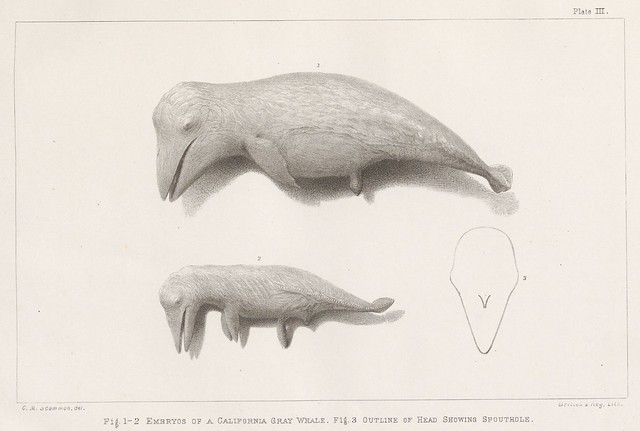
Embyros of a California Gray Whale
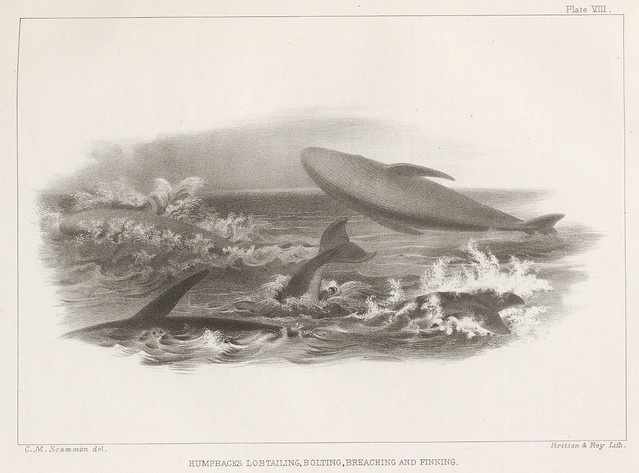
Humpbacks lobtailing, breaching and finning

The Sulphurbottom (Sibbaldius sulfureus, Cope.)

Fig. 1. The California Gray Whale (Rhachieanectes claucus Cope.)
Fig. 2. The Finback (Balaenoptera velifera, Cope.)
"The heroic and often tragic stories of American whalemen were renowned. They sailed the world’s oceans and brought back tales filled with bravery, perseverance, endurance, and survival. They mutinied, murdered, rioted, deserted, drank, sang, spun yarns, scrimshawed, and recorded their musings and observations in journals and letters. They survived boredom, backbreaking work, tempestuous seas, floggings, pirates, putrid food, and unimaginable cold. Enemies preyed on them in times of war, and competitors envied them in times of peace.
Many whalemen died from violent encounters with whales and from terrible miscalculations about the unforgiving nature of nature itself. And through it all, whalemen, those “iron men in wooden boats” created a legacy of dramatic, poignant, and at times horrific stories that can still stir our emotions and animate the most primal part of our imaginations. “To produce a mighty book, you must choose a mighty theme,” proclaimed Herman Melville, and the epic story of whaling is one of the mightiest themes in American history."
'Leviathan: The History of Whaling in America' by Eric Jay Dolin, 2008
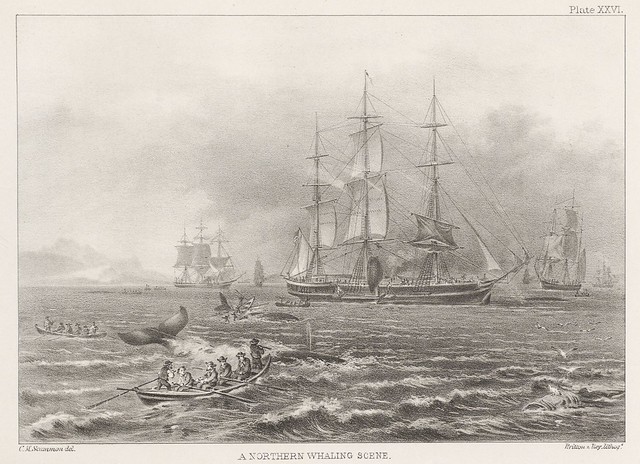
A northern whaling scene
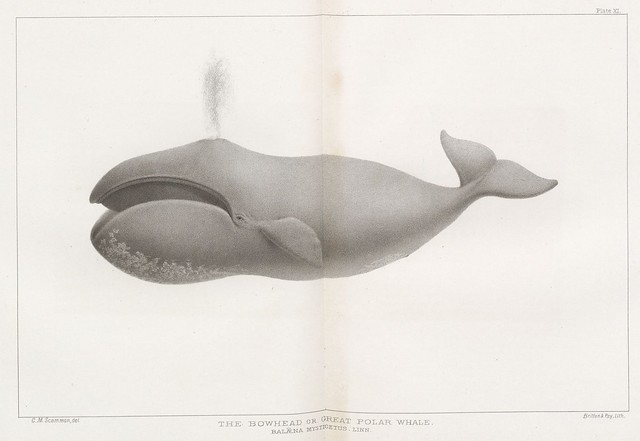
The Bowhead or Great Polar Whale (Balaena mysticetus. Linn.)
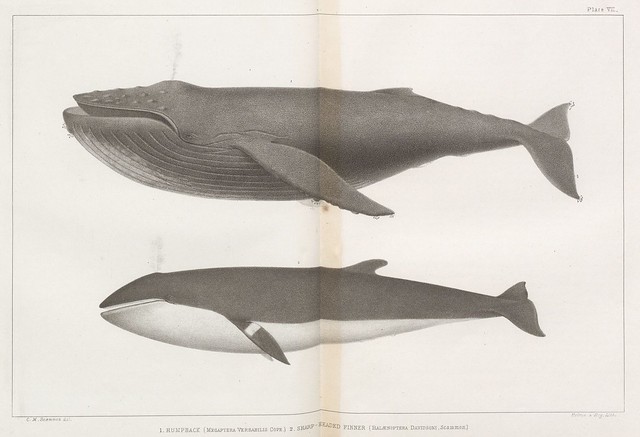
1. Humpback (Megaptera versabilis Cope.)
2. Sharp-headed Finner (Balaenoptera davidsoni.Scammon.)

Right whale of the North East coast (Balaena sieboldii, Gray.)
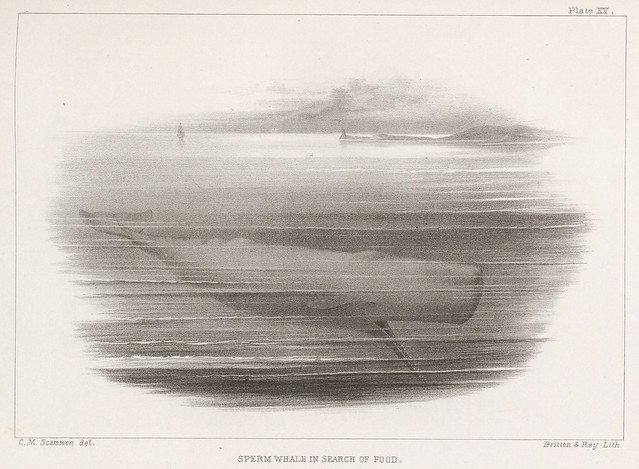
Sperm whale in search of food
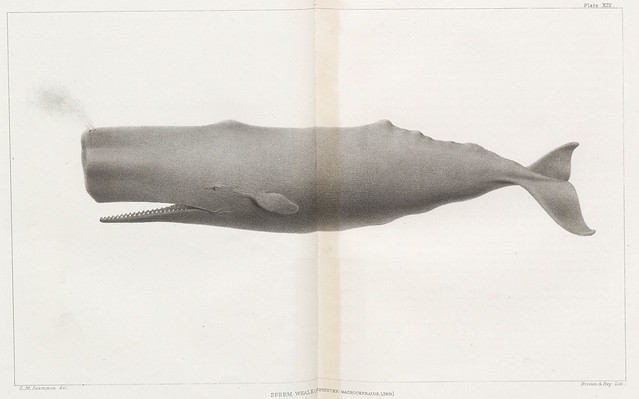
Sperm Whale (Physeter macrocephalus, Linn.)
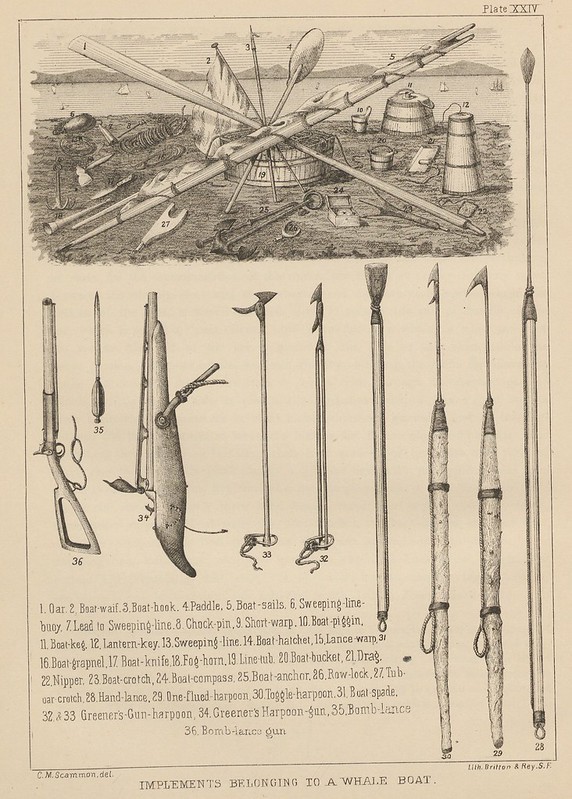
Implements belonging to a whale boat
1. Oar 2. Boat-waif 3. Boat-hook 4. Paddle 5. Boat-sails 6. Sweeping-line-buoy 7. Lead to Sweeping line 8. Chock-pin 9. Short-warp 10. Boat-piggin 11. Boat-keg 12. Lantern-key 13. Sweeping-line 14. Boat-hatchet 15. Lance-warp 16. Boat-grapnel 17. Boat-knife 18. Fog-horn 19. Line-tub 20. Boat-bucket 21. Drag 22. Nipper 23. Boat-crotch 24. Boat-compass 25. Boat-anchor 26. Row-lock 27. Tub-oar-crotch 28. Hand-lance 29. One-flued-harpoon 30. Toggle-harpoon 31. Boat-spade 32&33. Greener's-gun-harpoon 34. Greener's harpoon-gun 35. Bomb-lance 36. Bomb-lance gun
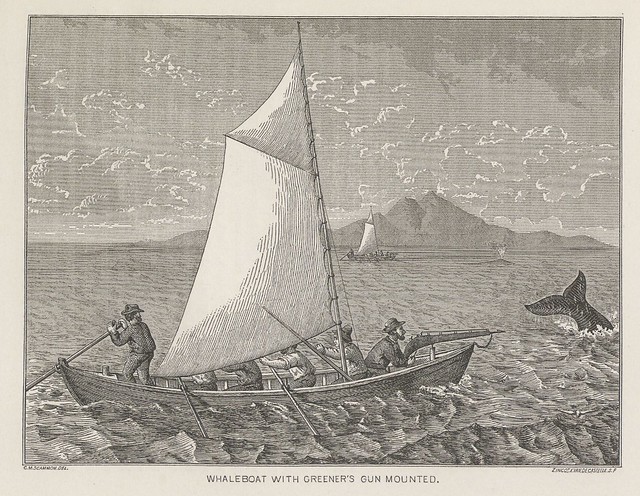
Whaleboat with Greener's gun mounted
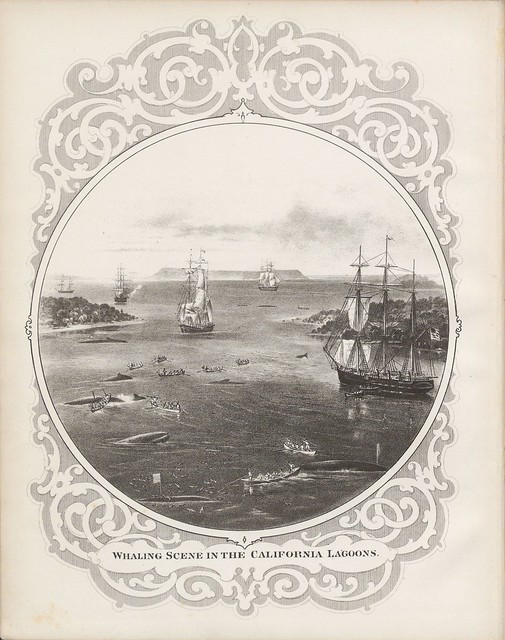
Whaling Scene in the California Lagoons
Charles Melville Scammon (1825-1911) was a whaler, naturalist, and author. Rather than do a poor job of repetition or regurgitation, I recommend you read the presentation post from Harvard's Iceberg blog:
"Charles Melville Scammon, was an unconventional man for the 19th century, being both a naturalist and a whaling captain. Scammon was born in Maine, where he skippered a number of merchant vessels across the Atlantic. Like many other Americans in 1849, he turned his attention westward with the Gold Rush in hopes of gaining a better living. In California, he commanded a number of whaling vessels during the 1860s and 1870s, becoming the first to hunt the gray whales off the California/Baha coastline and eventually contributing to the near extinction of the species. Ironically, he was not just an accomplished hunter, but also a careful and passionate observer of marine life and behavior, filling up numerous journals and sketchbooks during his voyages...[more]"
- 'The marine mammals of the north-western coast of North America described and illustrated : together with an account of the American whale-fishery' 1874 by Charles Melville Scammon is available online via Harvard University. [also: Internet Archive]
- "The Whaler who became a Naturalist" (book chapter) by Dick Russell. [W]
- The biographical chapter on Scammon is accessible at Google books from 'Early American Nature Writers: a Biographical Encyclopedia' by D Patterson (2007) [Amazon].
- 'Scammon: Beyond the lagoon : a biography of Charles Melville Scammon' 1986 by LB Landauer (Pacific maritime history series).
- CM Scammon titles at the Biodiversity Heritage Library.
"All that most maddens and torments; all that stirs up the lees of things; all truth with malice in it; all that cracks the sinews and cakes the brain; all the subtle demonisms of life and thought; all evil, to crazy Ahab, were visibly personified, and made practically assailable in Moby Dick. He piled upon the whale’s white hump the sum of all the general rage and hate felt by his whole race from Adam down; and then, as if his chest had been a mortar, he burst his hot heart’s shell upon it."
Herman Melville: 'Moby-Dick', 1851



















3 comments :
thank you for sharing
Here is a collection of whaling ship logs from the Cincinnati Public Library:
http://virtuallibrary.cincinnatilibrary.org/virtuallibrary/vl_CinciRoom.aspx?CityID=10
Thanks Kevin.
Post a Comment
Comments are all moderated so don't waste your time spamming: they will never show up.
If you include ANY links that aren't pertinent to the blog post or discussion they will be deleted and a rash will break out in your underwear.
Also: please play the ball and not the person.
Note: only a member of this blog may post a comment.